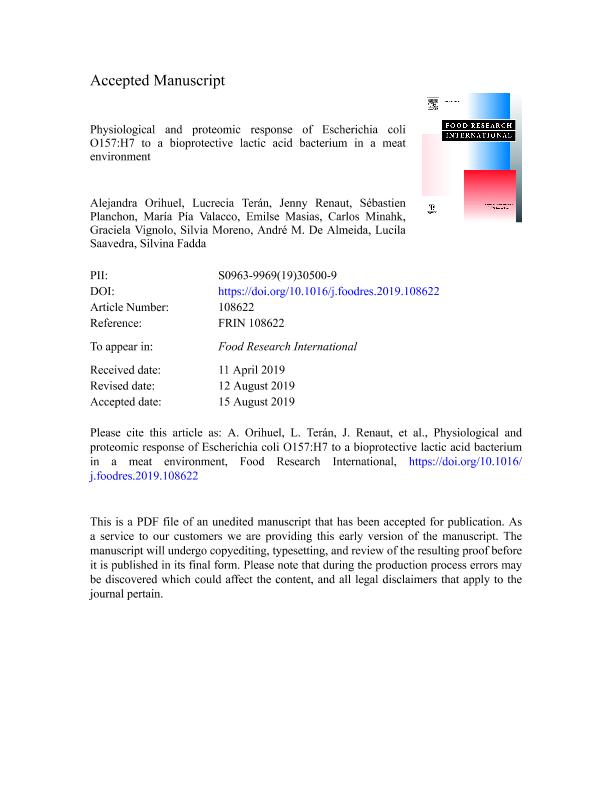Artículo
Physiological and proteomic response of Escherichia coli O157:H7 to a bioprotective lactic acid bacterium in a meat environment
Orihuel, Alejandra ; Teran, Lucrecia Cecilia
; Teran, Lucrecia Cecilia ; Renaut, Jenny; Planchon, Sébastien; Valacco, Maria Pia
; Renaut, Jenny; Planchon, Sébastien; Valacco, Maria Pia ; Masias, Ruth Emilse
; Masias, Ruth Emilse ; Minahk, Carlos Javier
; Minahk, Carlos Javier ; Vignolo, Graciela Margarita
; Vignolo, Graciela Margarita ; Moreno, Silvia Margarita
; Moreno, Silvia Margarita ; Almeida, André Martinho de; Saavedra, Maria Lucila
; Almeida, André Martinho de; Saavedra, Maria Lucila ; Fadda, Silvina G.
; Fadda, Silvina G.
 ; Teran, Lucrecia Cecilia
; Teran, Lucrecia Cecilia ; Renaut, Jenny; Planchon, Sébastien; Valacco, Maria Pia
; Renaut, Jenny; Planchon, Sébastien; Valacco, Maria Pia ; Masias, Ruth Emilse
; Masias, Ruth Emilse ; Minahk, Carlos Javier
; Minahk, Carlos Javier ; Vignolo, Graciela Margarita
; Vignolo, Graciela Margarita ; Moreno, Silvia Margarita
; Moreno, Silvia Margarita ; Almeida, André Martinho de; Saavedra, Maria Lucila
; Almeida, André Martinho de; Saavedra, Maria Lucila ; Fadda, Silvina G.
; Fadda, Silvina G.
Fecha de publicación:
11/2019
Editorial:
Elsevier Science
Revista:
Food Research International
ISSN:
0963-9969
e-ISSN:
1873-7145
Idioma:
Inglés
Tipo de recurso:
Artículo publicado
Clasificación temática:
Resumen
The enterohemorrhagic Escherichia (E.) coli (EHEC) is a pathogen of great concern for public health and the meat industry all over the world. The high economic losses in meat industry and the high costs of the illness highlight the necessity of additional efforts to control this pathogen. Previous studies have demonstrated the inhibitory activity of Enterococcus mundtii CRL35 towards EHEC, showing a specific proteomic response during the co-culture. In the present work, additional studies of the EHEC-Ent. mundtii interaction were carried out: i) differential protein expression of E. coli O157:H7 NCTC12900 growing in co-culture with Ent. mundtii in a meat environment, ii) the reciprocal influence between these two microorganisms in the adhesion to extracellular matrix (ECM) proteins and iii) the possible induction of the phage W933, coding for Shiga toxin (Stx1), by Ent. mundtii CRL35. Proteomic analysis showed a significant repression of a number of E. coli NCTC12900 proteins in co-culture respect to its single culture, these mostly related to the metabolism and transport of amino acids and nucleotides. On the other hand, statistically significant overexpression of EHEC proteins involved in stress, energy production, amino acid metabolism and transcription was observed at 30 h respect to 6 h when EHEC grew in co-culture. Data are available via ProteomeXchange with identifier PXD014588. Besides, EHEC showed a decreased adhesion capacity to ECM proteins in the presence of the bioprotective strain. Finally, Ent. mundtii CRL35 did not induce the lytic cycle of W933 bacteriophage, thus indicating its potential safe use for eliminating this pathogen. Overall, this study expands the knowledge of EHEC- Ent. mundtii CRL35 interaction in a meat environment, which will certainly contribute to find out effective biological strategies to eliminate this pathogen.
Archivos asociados
Licencia
Identificadores
Colecciones
Articulos(CERELA)
Articulos de CENTRO DE REFERENCIA PARA LACTOBACILOS (I)
Articulos de CENTRO DE REFERENCIA PARA LACTOBACILOS (I)
Articulos(INSIBIO)
Articulos de INST.SUP.DE INVEST.BIOLOGICAS
Articulos de INST.SUP.DE INVEST.BIOLOGICAS
Articulos(IQUIBICEN)
Articulos de INSTITUTO DE QUIMICA BIOLOGICA DE LA FACULTAD DE CS. EXACTAS Y NATURALES
Articulos de INSTITUTO DE QUIMICA BIOLOGICA DE LA FACULTAD DE CS. EXACTAS Y NATURALES
Citación
Orihuel, Alejandra; Teran, Lucrecia Cecilia; Renaut, Jenny; Planchon, Sébastien; Valacco, Maria Pia; et al.; Physiological and proteomic response of Escherichia coli O157:H7 to a bioprotective lactic acid bacterium in a meat environment; Elsevier Science; Food Research International; 125; 11-2019; 1-14
Compartir
Altmétricas



